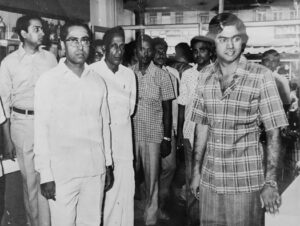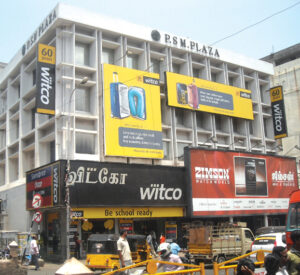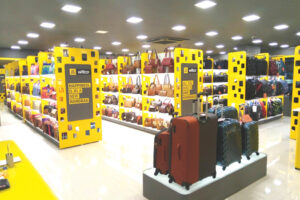Registered with the Registrar of Newspapers for India under R.N.I 53640/91
Vol. XXXI No. 6, July 1-15, 2021
The Witco Story
by V.P. Harris
Witco, the iconic Chennai brand, began to wind up its business last year. Its closure has evoked warm memories from many Chennai-ites who were the brand’s patrons. We thank V.P. Harris who is from the family that ran the chain for this article.
– The Editor.
My father M.P.C. Mohamed was born in a village an hour’s drive from Kannur, Kerala. Though a large part of our family was into agriculture, he decided to build a career in commercial business. He worked for an uncle for a year or so, near Kannur. Then, he moved to Mumbai to work with another uncle. My father sensed the opportunity for a new business trading in bags and luggage – there was market demand for it and he had access to manufacturers. And so, he moved to Madras and started the West India Plastics Trading Company in 1951. The short form of the company discarded the ‘p’ of plastics, giving us the name that many are so familiar with today – WITCO.

At the inauguration of Witco’s Mount Road branch, 1970s.
Witco opened its first store at George Town, at the junction of Kasi Chetty and Narayana Mudali streets. In those days, Madras was the capital of the Madras Presidency, which covered most of South India. People gravitated to the metro from Andhra, Karnataka and Kerala – and many became patrons of our store, which evolved into a trading hub for bags and luggage in the South Indian market. Our store staff was a fantastic lot. Most of them were from my father’s tiny village. They picked up many languages while interacting with the clientele and suppliers – speaking Telugu, Kannada, Hindi and of course Tamil, apart from Malayalam. Their conversations were quite colourful. The staff were also familiar with the wholesale and retail prices of each and every product, this despite there being then no barcode reader or price label! You had to be quick on your toes with mental maths to manage the store, too.
After a while, Witco branched out into manufacturing bags, belts and purses. We even made plywood fabricated luggage, which the present generation may not be aware of. They are probably familiar with moulded and soft luggage; people may even be familiar with the steel trunks which are still in use by some people in the army. Plywood fabricated luggage was sort of in-between steel trunks and the moulded soft luggage of today. Making it was an elaborate process. It was a totally hand-crafted product. First, a carpentry team (dominated by Keralites) made the shell, which was predominantly plywood with solid wood in the corners. Then, teams from Uttar Pradesh and Bihar – who had experience in the shoe making industry – developed the shell into a suitcase. They would cover the inner surface with a fabric lining and pocket, stick synthetic leather on the outside and add locks, handles, hinges and bushes for the bottom.
It was around the time that Witco’s manufacturing venture picked up pace that the nation’s states went through a re-configuration. Madras Presidency existed until the mid-50’s and everything changed after that. Kerala and Karnataka went through re-organisation as did Andhra, which used to be a large part of the Madras Presidency. This had an impact on the market, of course. Witco had to adapt to the new environment and so, the business began to open stores in other cities. Our stores in Calicut, Cochin and Coimbatore were the first to come up this way. Our expansion paved the way for what I call the company’s ‘superstore era’.
My father was a pioneer of his times. He conducted painstaking research to bring innovation to his business. So highly regarded by his competitors was he that almost every experiment he conducted was dutifully copied in the market. Even when he began to publish new year diaries – a product that had no correlation with the brand at that time – others followed suit. Sometimes, they even did a better job than he did – after all, they had all the benefit of my father’s learnings without the risk of trying something completely new!
On March 7th, 1975, my father passed away in a tragic car accident near Kanchipuram on the Bengaluru Chennai highway. My brother Nurdeen, my sister Razia and I inherited the business overnight. We were guided by our mother Mrs. Ayesha and uncle, Mr. P. Mohamed, in taking the business forward.
By this time, plywood luggage had become extinct and over the decade, all manufacturing activities ceased. Consequently, the wholesale trade also died down. And so, Witco focused on moulded and soft luggage, soon becoming the largest South Indian retailer of brands in this space. The company’s portfolio also expanded to retailing apparel, gifts, rainwear and toys.
The second generation of owners opened their first Witco store at Anna Salai in 1976. We hired a US-trained designer to fashion our store – it may seem strange to mention this point today, but it was considered highly unusual to hire a professional store designer at that time. We also realised that the market was undergoing a transformation – the consumer base was changing, demand was changing and new opportunities presented themselves. We took moves to adapt and leverage circumstances to our benefit.

Above: Witco’s T. Nagar branch and below: its Anna Nagar counterpart.
We also held periodic store events at the Anna Salai/Mount Road store to attract customers, a pioneering marketing move in those days. In fact, it was unheard of to visually display a single category of products and invite interested customers to shop. It was a bold move, but we decided to try it out and advertised such events, too. For instance, our ‘Handbag Exhibition and Sale’ offered customers a variety of handbags and the entire store was stocked accordingly. Our risks paid off – the handbag event was a runway success. Soon, we launched other events like Baby Care Week and Kitchenware Expo too. All our events were ten days long inclusive of two weekends, always held during the first week of the month.
Our kids wear section soon became a key part of the Witco portfolio. In fact, market research reports showed that Witco was second only to the leading brand Naidu Hall in this category. We soon exited George Town and moved to the best suburbs in the city, occupying 5,000 to 1,000 square feet multi-level stores.

The last twenty years of Witco can be described as the speciality retail era, where the focus was on the premium segment – essentially, international air travel. Post liberalisation, global brands such as Samsonite made a headway into the Indian market while national giant VIP also upgraded their offering. Witco too, of course, upgraded stores to meet and exceed market expectations.
We never stopped innovating – in recent times, we spearheaded Witco’s move into digital platforms and re-designed our stores at malls, too. For instance, our R.K. Mutt store was re-designed beautifully. However, we were already struggling under the impact of demonetisation, which had eaten into our sales. The pandemic was the nail in the coffin, so to speak. And with that an iconic brand that was born in Chennai ceased to exist.

